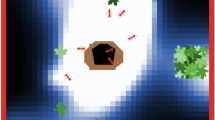Abstract
The present article introduces the system BioAnt, which is a computational simulation of a small colony of ants (up to 99 members) in which every ant relies on a biologically more plausible artificial neural networks as control mechanism for guidance. The environment, in which the ants are placed, is three-dimensional, consisting of the anthill, sugar, water, earth elevations, walls and predators. The ants’ foraging behavior was successfully implemented as well as some basic defense mechanisms. Typical sensors and actuators of ants were modeled and the efficiency of the connectionist approach has been validated by the comparison with a simple symbolical approach. Apart from several surprising results on technical details, which are reported, the present approach clearly demonstrates the feasibility of such an implementation with connectionist and biologically more plausible principles, offering promising perspectives as a basis for further artificial life systems.





Similar content being viewed by others
Explore related subjects
Discover the latest articles, news and stories from top researchers in related subjects.References
Bonabeau E, Dorigo M, Theraulaz G (1999) Swarm intelligence: from natural to artificial systems. Oxford University Press, New York
Dorigo M, Di Caro G (1999) Ant algorithms for discrete optimization. Artif Intell 5:137–172
Gordon D (1999) Ants at work: how an insect society is organized. Free, New York
Haykin S (1999) Neural networks: a comprehensive foundation, 2nd edn. Prentice Hall, Englewood Cliffs
Hölldobler B, Wilson EO (1990) The ants. Harvard University Press, Cambridge
Johnson S (2001) Emergence: the connected lives of ants, brains, cities and softwares. Scribner, New York
Klügl F, Oechslein C, Puppe F (2001) Artificial Life Modelle für soziale Insekten. In: Wittmann J, Bernaard L (eds). Simulation in Geo- und Umweltwissenschaften: Workshop Münster. Shaker, Aachen, pp 35–47
Miramontes O, Solé RV, Goodwin BC (1993) Antichaos in ants: the excitability metaphor at two hierarchical levels. In: Proceedings of the second European conference on artificial life. Brussels, Belgium, p 790
O’Reilly RC (1996) Biologically plausible error-driven learning using local activation differences: the generalized recirculation algorithm. Neural Comput: 895–938
O’Reilly RC (1998) Six principles for biologically-based computational models for cortical cogniation. Trends Cognit Sci 2:455–462
Rosa JLG (2002) A biologically inspired connectionist system for natural language processing. In: Proceedings of the VII Brazilian symposium on neural networks. IEEE Computer Society Press, Recife, pp 243–248
Schneider MO, Rosa JLG (2002) Neural connect 4—A connectionist approach to the game. In: Proceedings of the VII Brazilian symposium on neural networks. IEEE Computer Society Press, Recife, pp 236–241
Schneider MO, Rosa JLG (2003) Neural labyrinth robot—finding the best way in a connectionist fashion. In: Anais do XXIII Congresso da Sociedade Brasileira de Computação, Campinas 1, p 151
Schneider MO, Rosa JLG (2005) BioAnt—biologically plausible computer simulation of an environment with ants. In: Proceedings of the international joint conference on neural networks, Montreal, Canada, pp 1505–1510
Woolridge M (2003) Introduction to multiagent systems. Wiley, John and Sons Incorporated, London, Bristol
Author information
Authors and Affiliations
Corresponding author
Rights and permissions
About this article
Cite this article
Schneider, M.O., Rosa, J.L.G. Application and development of biologically plausible neural networks in a multiagent artificial life system. Neural Comput & Applic 18, 65–75 (2009). https://doi.org/10.1007/s00521-007-0156-0
Received:
Accepted:
Published:
Issue Date:
DOI: https://doi.org/10.1007/s00521-007-0156-0




